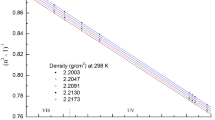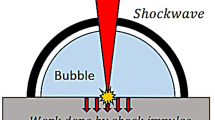Abstract.
Heating rates after photoexcitation of several organic molecules have been studied by the transient grating spectroscopy with sub-picosecond laser pulses in solution and supercritical fluids. The rise time of the acoustic signal produced by the energy dissipation process of the hot ground state molecule was monitored. The acoustic signal was analyzed by an equation including the acoustic damping. The solvent temperature rise times in various media have been determined. The temperature rise times in solutions were longer than the vibrational energy relaxation times of the solutes determined by the transient absorption measurements. The difference was discussed in terms of the contribution of vibrational states in the energy transfer pathways from the solute to the solvent. It was found that the hydrogen-bonding between the solute and solvent play important roles in determining the energy transfer pathway from the solute to the solvent.
Similar content being viewed by others
References
A. Seilmeier, W. Kaiser, in Ultrafast Laser Pulses, Generation and Applications, edited by W. Kaiser, 2nd edn. (Springer-Verlag, Berlin, 1992), p. 280
J.C. Owrutsky, D. Raftery, R.M. Hochstrasser, Ann. Rev. Phys. Chem. 45, 519 (1994)
S. Mukamel, Principles of Nonlinear Optical Spectroscopy (Oxford University Press, New York, 1995)
H.J. Eichler, P. Gunter, D.W. Pohl, Laser-Induced Dynamic Gratings (Springer-Verlag, Berlin, 1986)
M. Takezaki, N. Hirota, M. Terazima, J. Phys. Chem. A 101, 3443 (1997)
M. Terazima, M. Takezaki, S. Yamaguchi, N. Hirota, J. Chem. Phys. 109, 603 (1998)
T. Okazaki, N. Hirota, M. Terazima, J. Chem. Phys. 110, 11399 (1999)
M. Terazima, Chem. Phys. Lett. 305, 189 (1999)
N. Saga, Y. Kimura, N. Hirota, M. Terazima, Chem. Phys. Lett. 332, 496 (2000)
Y. Kimura, Y. Yamamoto, H. Fujiwara, M. Terazima, J. Chem. Phys. 123, 054512 (2005)
Y. Kimura, Y. Yamamoto, M. Terazima, J. Chem. Phys. 123, 054513 (2005)
Y. Kimura, M. Fukuda, O. Kajimoto, M. Terazima, J. Chem. Phys. 125, 194516 (2006)
D. Schwarzer, J. Troe, M. Votsmeier, M. Zerezke, J. Chem. Phys. 105, 3121 (1996)
D. Schwarzer, J. Troe, M. Votsmeier, M. Zerezke, Ber. Bunsenges. Phys. Chem. 101, 595 (1997)
D. Schwarzer, J. Troe, M. Zerezke, J. Chem. Phys. 107, 8380 (1997)
D. Schwarzer, J. Troe, M. Zerezke, J. Phys. Chem. A 102, 4207 (1998)
S.A. Kovalenko, R. Shcanz, H. Hennig, N.P. Ernsting, J. Chem. Phys. 115, 3256 (2001)
Author information
Authors and Affiliations
Rights and permissions
About this article
Cite this article
Terazima, M. Initial heating mechanism of fluids after photoexcitation of molecules in various phases. Eur. Phys. J. Spec. Top. 153, 19–24 (2008). https://doi.org/10.1140/epjst/e2008-00384-9
Issue Date:
DOI: https://doi.org/10.1140/epjst/e2008-00384-9




